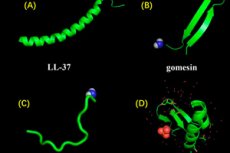New publications
Peptide hydrogel enhances the effectiveness of antibiotics against resistant bacteria
Last reviewed: 02.07.2025

All iLive content is medically reviewed or fact checked to ensure as much factual accuracy as possible.
We have strict sourcing guidelines and only link to reputable media sites, academic research institutions and, whenever possible, medically peer reviewed studies. Note that the numbers in parentheses ([1], [2], etc.) are clickable links to these studies.
If you feel that any of our content is inaccurate, out-of-date, or otherwise questionable, please select it and press Ctrl + Enter.

Researchers at Chalmers University of Technology in Sweden have discovered that resistant bacteria can become susceptible to antibiotics again if the treatment is combined with a material containing antibacterial peptides. The laboratory study found that combining antibiotics with the material increases their bactericidal effect by 64 times, and the antibacterial properties of the material itself are significantly enhanced.
Material with antibacterial peptides
The material, designed for medical applications, is a specially created hydrogel with antibacterial peptides – molecules that are also building blocks of proteins. It has been studied by researchers for many years and has demonstrated a high ability to kill various types of bacteria, including antibiotic-resistant ones.
Key findings of the study
- The hydrogel was tested on bacterial cultures with the antibiotics oxacillin and vancomycin.
- The greatest effect was found in the combination of hydrogel with oxacillin against MRSA (methicillin-resistant S. aureus). The concentration of oxacillin required to suppress bacteria decreased by 64 times, which lowered it below the resistance threshold.
- With vancomycin, the effect was additive but not synergistic.
Stability and duration of action
Previously, antibacterial peptides were combined with antibiotics in solutions, but they quickly lost their effectiveness when in contact with body fluids, such as blood. However, in the hydrogel, the peptides become much more stable and can remain active for several days.
Potential applications
The hydrogel can be applied locally, limiting the impact on the entire body. Researchers highlight the following advantages:
- Wound Treatment: Use of the material may increase the effectiveness of antibiotics and reduce the need for additional medications.
- Infection prevention: Hydrogel can be used to prevent infections after surgery or at home as a “smart” patch.
- Veterinary and Healthcare: A hydrogel dressing for veterinary use is planned for launch in eight European countries this fall. The development for human use is undergoing approval in the US, and researchers expect it to be available on the market within a year.
Mechanism of action and benefits
Antibacterial peptides destroy bacterial cell membranes by interacting with the positive charges of the peptides and the negative charges of the membranes. Previously, a synergistic effect with antibiotics was demonstrated only for free peptides, but Chalmers' study is the first to show the effectiveness of peptides fixed in a material.
The Future of Development
The research is being conducted in collaboration with Amferia, which is commercializing the results. In addition to wound treatment, the material can be used in coatings for medical devices, which minimizes the risk of infection when they are introduced into the body.
These findings open up new possibilities in the fight against antibiotic-resistant infections, making it possible to improve the effectiveness of standard treatments and reduce the risk of complications.
